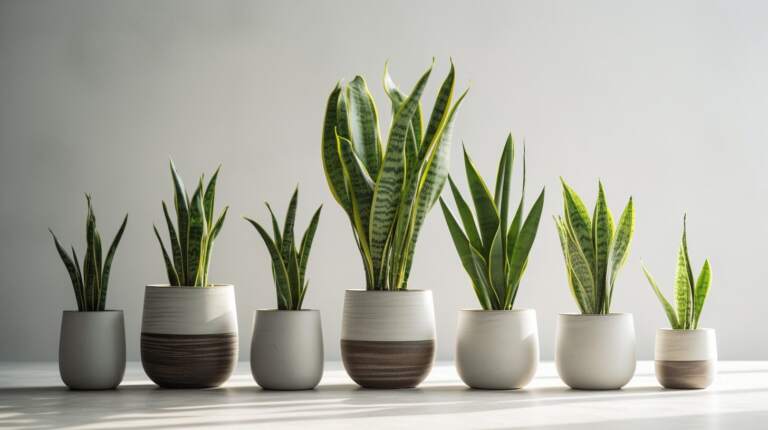In the lush landscape of plant care, understanding the needs of your Chinese Evergreen is akin to deciphering the whispers of nature.
With its vibrant foliage and unique water requirements, this tropical beauty requires a discerning eye to recognize the signs of dehydration.
In this article, we will delve into the art of observing, testing, and watering, equipping you with the knowledge to nourish your Chinese Evergreen and ensure its flourishing vitality.
Join us on this journey of serving nature’s wonders.
Key Takeaways
- Water requirements vary based on light, temperature, and humidity
- Wilting leaves indicate lack of water, while yellowing leaves can be a sign of overwatering
- Assess soil moisture using the finger test or a moisture meter
- Factors such as soil type, environmental conditions, and plant size/growth stage influence the frequency of watering
Understanding the Chinese Evergreen(Aglaonema) Water Requirements
The Chinese Evergreen’s natural water requirements can vary based on factors such as light, temperature, and humidity. Understanding these requirements is crucial in maintaining the health and vitality of your plant.
When it comes to the watering schedule, it is important to strike a balance between under-watering and over-watering. The Chinese Evergreen prefers slightly moist soil, so it is advisable to water it when the top inch of the soil feels dry to the touch. However, be cautious not to let the plant sit in standing water, as this can lead to root rot.
As for watering techniques, it is best to water the plant thoroughly, allowing the water to penetrate the soil and reach the roots. Avoid using cold water, as it can shock the plant. Additionally, consider using room temperature or lukewarm water to ensure optimal growth.
Observing the Signs of Dehydration in Your Chinese Evergreen
As you closely monitor the health of your Chinese Evergreen, it is crucial to observe the signs of dehydration, so you can take prompt action to quench its thirst. Here are some key indicators to look out for:
- Wilting leaves: If the leaves of your Chinese Evergreen are drooping or becoming limp, it may be a sign that the plant is not receiving enough water.
- Dry soil: Check the moisture level of the soil by sticking your finger about an inch deep into it. If the soil feels dry, it’s an indication that your plant needs water.
- Yellowing leaves: Overwatering can also lead to yellowing leaves, so it’s important to differentiate between underwatering and overwatering.
By identifying overwatering in Chinese Evergreen and troubleshooting common watering mistakes, you can ensure that your plant receives the right amount of water.
Now, let’s move on to the next section to learn about testing the soil moisture levels for accurate watering.
Testing the Soil Moisture Levels for Accurate Watering
Assessing the soil moisture levels is an essential step in accurately determining when to water your Chinese Evergreen. By measuring the moisture content in the soil, you can avoid both overwatering and underwatering your plant. There are several techniques you can use to test the soil moisture levels. One common method is the finger test, where you stick your finger about an inch into the soil and check for moisture. Another method is using a moisture meter, which provides a more precise measurement. However, it is important to avoid common mistakes when testing soil moisture. These include not testing at the root level, not considering the type of soil, and relying solely on visual cues. By using proper measuring techniques and avoiding common mistakes, you can accurately determine when to water your Chinese Evergreen.
| Measuring Techniques | Common Mistakes |
|---|---|
| Finger test | Not testing at the root level |
| Moisture meter | Not considering the type of soil |
| Relying solely on visual cues |
Factors That Influence the Frequency of Watering for Chinese Evergreens
Watering frequency for Chinese Evergreens is influenced by various factors. To ensure your plant thrives, consider the following:
- Type of Soil: Different soil types retain moisture differently. Well-draining soil, such as a mixture of potting soil and perlite, requires less frequent watering compared to heavy, clay-based soil.
- Environmental Conditions: Factors like temperature, humidity, and sunlight affect the rate at which water evaporates from the soil. Higher temperatures and low humidity levels may necessitate more frequent watering.
- Plant Size and Growth Stage: Younger plants and those in active growth stages require more water than mature, established ones.
Understanding these factors will help you determine an appropriate watering schedule and ensure your Chinese Evergreen receives the right amount of water.
Now, let’s explore the best practices for watering your Chinese Evergreen plant.
Best Practices for Watering Your Chinese Evergreen Plant
Two key practices for watering your Chinese Evergreen plant are ensuring proper drainage and maintaining a consistent watering schedule. Proper drainage is essential to prevent water from sitting in the pot, which can lead to root rot and other issues. To achieve this, make sure your pot has drainage holes and use a well-draining soil mix. In terms of watering schedule, Chinese Evergreens prefer to be slightly on the drier side, so it is important not to overwater them. A good rule of thumb is to water your plant when the top inch of soil feels dry to the touch. Overwatering can result in root rot and other problems, so it’s important to pay attention to signs of overwatering such as yellowing leaves, wilting, and a foul smell coming from the soil.
To help you better understand these practices, here is a table summarizing the key watering techniques and signs of overwatering for Chinese Evergreen plants:
| Watering Techniques | Signs of Overwatering |
|---|---|
| Ensure proper drainage by using a pot with drainage holes and a well-draining soil mix | Yellowing leaves |
| Maintain a consistent watering schedule, watering when the top inch of soil feels dry | Wilting |
| Avoid overwatering, as it can cause root rot and other problems | Foul smell from soil |
Frequently Asked Questions
Can I Use Tap Water to Water My Chinese Evergreen, or Do I Need to Use Filtered Water?
Tap water can be used to water Chinese Evergreen plants, but it is recommended to use filtered water for optimal growth. Tap water may contain minerals, chlorine, or other chemicals that can potentially harm the plant over time.
Filtered water helps to remove these impurities, providing a healthier environment for the Chinese Evergreen.
Additionally, misting the plant regularly can increase humidity levels, which is beneficial for this tropical plant species.
Should I Mist My Chinese Evergreen to Increase Humidity, or Is Regular Watering Sufficient?
Misting your Chinese Evergreen can be beneficial in increasing humidity levels, especially in dry indoor environments. While regular watering is essential for the plant’s overall health, misting can provide additional moisture to the leaves, promoting optimal growth.
However, it is important to avoid overwatering as this can lead to root rot and other issues. Signs of overwatering include yellowing leaves, wilting, and a musty odor.
Therefore, a balance between regular watering and occasional misting is recommended for the Chinese Evergreen.
Can I Use Fertilizer When Watering My Chinese Evergreen, and if So, How Often Should I Do It?
Incorporating fertilizer into the watering routine of a Chinese Evergreen can indeed be beneficial for its growth and overall health. However, it is crucial to understand the appropriate frequency for such applications.
Fertilizing a Chinese Evergreen should be done sparingly, typically every 2 to 3 months during the growing season. Over-fertilization can lead to nutrient burn or other complications.
Always follow the recommended dosage instructions provided by the fertilizer manufacturer for optimal results.
What Are the Signs That Indicate My Chinese Evergreen Needs Water?
During the winter months, it is not uncommon for the leaves of Chinese evergreen plants to turn yellow and drop. This can be attributed to a decrease in light levels and a drop in temperature.
To prevent this, it is important to provide proper winter care for your Chinese evergreen. This includes placing it in a location with bright, indirect light and avoiding cold drafts.
Additionally, be mindful not to overwater the plant during this time, as it may further contribute to yellowing leaves.
Can I Place My Chinese Evergreen in a Self-Watering Pot, or Is It Better to Stick to Traditional Watering Methods?
When it comes to watering your Chinese Evergreen, you may be wondering if it’s better to use a self-watering pot or stick to traditional watering methods.
Self-watering pots offer several benefits for Chinese Evergreens, such as providing a consistent and controlled water supply, reducing the risk of overwatering or underwatering, and promoting healthier root growth.
However, traditional watering methods can also be effective if done correctly, allowing you to closely monitor the moisture levels and adjust accordingly.
Consider your personal preferences and the specific needs of your plant before making a decision.







